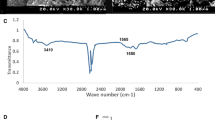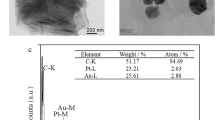Abstract
Protein adsorption onto solid surfaces is a complex process playing an important role in biological systems, being crucial to maintain the three-dimensional conformation during molecules interaction. Polymers hybrid network could be used to perform immunoassays with the required high level specificity. We have developed a novel route for incorporating recombinant protein from Bovine Herpesvirus into a network using as template Poly(vinyl alcohol) chemically tailored with five organosilanes followed by FTIR spectroscopy characterization. Protein expressed in E. coli was incorporated into hybrid network; all the PVA-hybrids interacted with this biomolecule and FTIR vibrational bands have endorsed the results. PVA hybrids modified with 3-(triethoxysilyl) propylisocyanate-TESPI presented the best result in the immunoassay, enhancing the sera specificity in comparison with the commercial microplate. We have successfully developed organic–inorganic hybrid based on PVA-silane to be used in serological tests with recombinant protein as a promising tool for the development and production new diagnostic assays.



Similar content being viewed by others
References
H.S. Mansur, R.L. Oréfice, A.A.P. Mansur, Characterization of poly(vinyl alcohol)/poly(ethylene glycol) hydrogels and PVA-derived hybrids by small-angle X-ray scattering and FTIR spectroscopy. Polymer (Guildf) 45, 7193 (2004). doi:10.1016/j.polymer.2004.08.036
A.E. Lima-Barros, A.M.P. Almeida, L.B. Carvalho Júnior, W.M. Azevedo, Polysiloxane/PVA—glutaraldehyde hybrid composite as solid phase for immunodetections by ELISA. Braz. J. Med. Biol. Res. 35, 459 (2002)
Y. Wang, J.L. Robertson, W.B. Spillman Jr, R.O. Claus, Effects of the chemical structure and the surface properties of polymeric biomaterials on their biocompatibility. Pharm. Res. 21, 1362 (2004). doi:10.1023/B:PHAM.0000036909.41843.18
E.F. Reis, F.S. Campos, A.P. Lage, R.C. Leite, L.G. Heneine, W.L. Vasconcelos et al., Synthesis and characterization of poly (vinyl alcohol) hydrogels and hybrids for rMPB70 protein adsorption. Mater. Res. 9, 185 (2006). doi:10.1590/S1516-14392006000200014
D.A. Afonso, L.S. Ortega, R.A. Redondo, G.S. Trindade, E.F. Barbosa-Stancioli, Characterization of field bovine herpesvirus samples using random amplified polymorphic DNA (RAPD). J. Virol. Methods 140(1–2), 200 (2007). doi:10.1016/j.jviromet.2006.10.010
O.P. Surujballi, M. Mallory, An indirect enzyme-linked immunosorbent assay for the detection of bovine anti-bodies to multiple Leptospira serovars. Can. J. Vet. Res. 68, 1 (2004)
G. Andrade, E.F. Barbosa-Stancioli, A.A. Piscitelli-Mansur, W.L. Vasconcelos, H.S. Mansur, Design of novel hybrid organic–inorganic nanostructured biomaterials for immunoassay applications. Biomed. Mater. 1, 221 (2006). doi:10.1088/1748-6041/1/4/008
G.I. Andrade, E.F. Barbosa-Stancioli, A.A. Piscitelli-Mansur, W.L. Vasconcelos, H.S. Mansur, Small-angle X-ray scattering and FTIR characterization of nanostructured poly (vinyl alcohol)/silicate hybrids for immunoassay applications. J. Mater. Sci. 43, 450–463 (2008)
S.J. Hopkins, A. Wormall, Phenyl isocyanate protein derivatives and their immunological properties—the amino-acid derivatives and serological inhibition tests. Biochem. J. 28, 228 (1934)
W.E. Gaunt, A. Wormall, The action of phenyl isocyanate on insulin. Biochem. J. 30, 1914 (1936)
B. Perdiguero, R. Blasco, Interaction between vaccinia virus extracellular virus envelope A33 and B5 glycoproteins. J. Virol. 80, 8763 (2006). doi:10.1128/JVI.00598-06
W.E. Brown, A.H. Green, T.E. Cedel, J. Cairns, Biochemistry of protein-isocyanate in teractions: a comparison of the effects of aryl vs. alkyl isocyanates. Environ. Health Perspect. 72, 5 (1987). doi:10.2307/3430269
J. Habsuda, G.P. Simon, Y.B. Cheng, D.G. Hewitt, D.A. Lewis, H. Toh, Organic–inorganic hybrids derived from 2-hydroxyethylmethacrylate and (3-methacryloyloxypropyl)trimethoxysilane. Polymer (Guildf) 43, 4123 (2002). doi:10.1016/S0032-3861(02)00246-X
I.C. Shekarchi, J.L. Sever, Y.J. Lee, G. Castellano, D.L. Madden, Evaluation of various plastic microtiter plates with measles, toxoplasma, gamma globulin antigens in enzyme-linked immunosorbent assays. J. Clin. Microbiol. 19, 89 (1984)
J. Wheeler, J. Simpson, A.R. Morley, Routine and rapid enzyme linked immunosorbent assays for circulating anti-glomerular basement membrane antibodies. J. Clin. Pathol. 41, 163 (1988). doi:10.1136/jcp.41.2.163
D. Avnir, S. Braun, O. Lev, M. Ottolenghi, Enzymes and other proteins entrapped in sol–gel materials. Chem. Mater. 6, 1605 (1994). doi:10.1021/cm00046a008
J. Livage, C. Roux, J.M. Da Costa, J.F. Quinson, I. Desportes, Immunoassays in sol–gel matrices. J. Sol–Gel. Sci. Technol. 7, 45 (1996). doi:10.1007/BF00401882
L.L. Hench, Sol–gel materials for bioceramic applications. Curr. Opin. Solid State Mater. Sci. 2, 604 (1997). doi:10.1016/S1359-0286(97)80053-8
I. Gill, A. Ballesteros, Bioencapsulation within synthetic polymers (Part 1): sol–gel encapsulated biologicals. Trends Biotechnol. 18, 282 (2000). doi:10.1016/S0167-7799(00)01457-8
W. Jin, J.D. Brennan, Properties and applications of proteins encapsulated within sol–gel derived materials. Anal. Chim. Acta 461, 1 (2002). doi:10.1016/S0003-2670(02)00229-5
Acknowledgments
The authors acknowledge CNPq/FAPEMIG/CAPES for financial support on this Project. HS Mansur, EF Barbosa-Stancioli and G. I. Andrade received research fellowship from CNPq, and R. M. Palhares and A. A. P. Mansur received fellowship from FAPEMIG.
Author information
Authors and Affiliations
Corresponding author
Rights and permissions
About this article
Cite this article
Mansur, H.S., Palhares, R.M., Andrade, G.I. et al. Improvement of viral recombinant protein-based immunoassays using nanostructured hybrids as solid support. J Mater Sci: Mater Med 20, 513–519 (2009). https://doi.org/10.1007/s10856-008-3606-z
Received:
Accepted:
Published:
Issue Date:
DOI: https://doi.org/10.1007/s10856-008-3606-z




